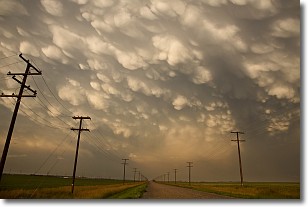Weather Alert in Texas
Flood Warning issued June 13 at 8:28AM CDT until June 15 at 4:50AM CDT by NWS Austin/San Antonio TX
AREAS AFFECTED: Karnes, TX; Wilson, TX
DESCRIPTION: ...Observed flooding changed to Minor severity and increased in duration for the following rivers in Texas... Cibolo Creek at Sutherland Springs affecting Karnes and Wilson Counties. ...The Flood Warning continues for the following rivers in Texas... San Antonio River Near Elmendorf affecting Bexar and Wilson Counties. San Antonio River near Floresville affecting Karnes and Wilson Counties. Cibolo Creek Near Falls City affecting Karnes County. * WHAT...Moderate flooding is forecast. * WHERE...San Antonio River near Floresville. * WHEN...From this morning to early Sunday morning. * IMPACTS...At 33.0 feet, Secondary roads near the floodplain may become flooded and impassable. Extensive flooding occurs in lowest portions of Floresville City Park. * ADDITIONAL DETAILS... - At 8:00 AM CDT Friday the stage was 19.4 feet. - Bankfull stage is 21.0 feet. - Forecast...The river is expected to rise above flood stage late this morning to a crest of 34.0 feet this evening. It will then fall below flood stage tomorrow afternoon. - Flood stage is 27.0 feet. - Flood History...This crest compares to a previous crest of 33.5 feet on 09/28/2016. - http://www.weather.gov/safety/flood
INSTRUCTION: Caution is urged when walking near riverbanks. Turn around, don't drown when encountering flooded roads. Most flood deaths occur in vehicles. Motorists should not attempt to drive around barricades or drive cars through flooded areas. Additional information is available at www.weather.gov. The next statement will be issued this evening at 745 PM CDT.
Want more detail? Get the Complete 7 Day and Night Detailed Forecast!
Current U.S. National Radar--Current
The Current National Weather Radar is shown below with a UTC Time (subtract 5 hours from UTC to get Eastern Time).

National Weather Forecast--Current
The Current National Weather Forecast and National Weather Map are shown below.

National Weather Forecast for Tomorrow
Tomorrow National Weather Forecast and Tomorrow National Weather Map are show below.

North America Water Vapor (Moisture)
This map shows recent moisture content over North America. Bright and colored areas show high moisture (ie, clouds); brown indicates very little moisture present; black indicates no moisture.

Weather Topic: What are Mammatus Clouds?
Home - Education - Cloud Types - Mammatus Clouds
 Next Topic: Nimbostratus Clouds
Next Topic: Nimbostratus Clouds
A mammatus cloud is a cloud with a unique feature which resembles
a web of pouches hanging along the base of the cloud.
In the United States, mammatus clouds tend to form in the warmer months, commonly
in the Midwest and eastern regions.
While they usually form at the bottom of a cumulonimbis cloud, they can also form
under altostratus, altocumulus, stratocumulus, and cirrus clouds. Mammatus clouds
warn that severe weather is close.
Next Topic: Nimbostratus Clouds
Weather Topic: What is Precipitation?
Home - Education - Precipitation - Precipitation
 Next Topic: Rain
Next Topic: Rain
Precipitation can refer to many different forms of water that
may fall from clouds. Precipitation occurs after a cloud has become saturated to
the point where its water particles are more dense than the air below the cloud.
In most cases, precipitation will reach the ground, but it is not uncommon for
precipitation to evaporate before it reaches the earth's surface.
When precipitation evaporates before it contacts the ground it is called Virga.
Graupel, hail, sleet, rain, drizzle, and snow are forms of precipitation, but fog
and mist are not considered precipitation because the water vapor which
constitutes them isn't dense enough to fall to the ground.
Next Topic: Rain
Current conditions powered by WeatherAPI.com




